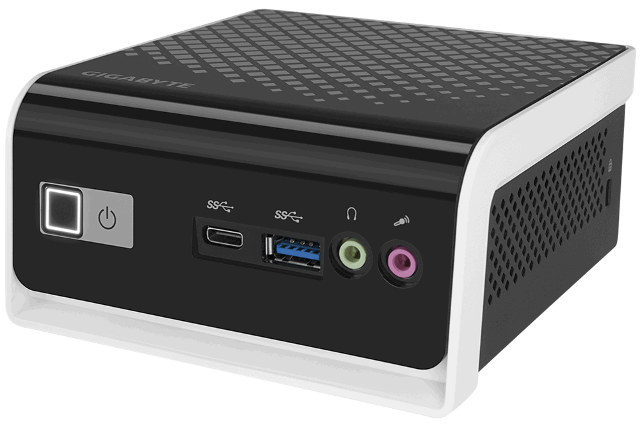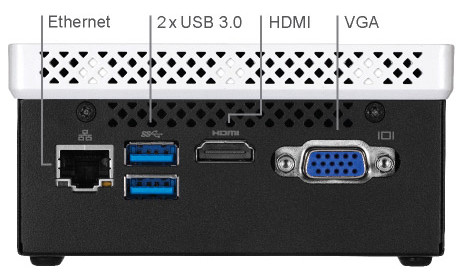GIGABYTE has already unveiled several Gemini Lake motherboards, but we’ve now learned the company has also updated their BRIX family of mini PCs with GB-BLCE-4000C model equipped with Intel Celeron N4000 dual core Gemini Lake processor.
The fanless “Ultra Compact PC kit” comes with HDMI and VGA video outputs, support for 2.5″ SATA drives, one DDR4 So-DIMM slot, four USB ports, and more.

GIGABYYRE BRIX Gemini Lake mini PC specifications:
- SoC – Intel Celeron N4000 dual core processor @ up to 2.6 GHz with Intel UHD Graphics 600; TDP 6W
- System Memory – 1x SO-DIMM DDR4 slot @ up to 2400MHz for 8GB RAM max
- Storage – 1x SATA III bay for 2.5″ HDD/SSD, 7.0/9.5 mm thick
- Video Output
- VGA up to 1920 x 1200 @ 60 Hz
- HDMI 1.4b up to 1920 x 1080 @ 60 Hz (TBC)
- Audio – Realtek ALC891 codec, headphone jack, microphone jack
- Connectivity – Gigabit Ethernet (via Realtek RTL8111HS), 802.11ac WiFi + Bluetooth 4.2 via Intel Dual Band Wireless-AC 3168 card
- USB – 3x USB 3.0 port, 1x USB 3.0 type C port
- Expansion Slots – 1x PCIe M.2 NGFF 2230 A-E key slot occupied by the WiFi+BT card
- Misc – 1x Kensington lock slot, power button
- Power Supply – 19V DC / 2.1A
- Dimensions – mini PC: 56.22 mm x 103 mm x 116.52 mm ; motherboard: 104 x 103 mm (how?)
- Temperature Range – 0°C to +35°C
The mini PC is said to support Windows 10 64-bit, and ships with 75×75 and 100x100m VESA brackets to mount behind compatible monitors/TVs. HDMI 1.4b is a little odd, as Gemini Lake processors support HDMI 2.0 natively, although in the past we’ve seen boards adding ah HDMI 2.0 re-timer buffer.
Availability and pricing are unknown as of writing. Visit the product page for more details.
Via FanlessTech

Jean-Luc started CNX Software in 2010 as a part-time endeavor, before quitting his job as a software engineering manager, and starting to write daily news, and reviews full time later in 2011.
Support CNX Software! Donate via cryptocurrencies, become a Patron on Patreon, or purchase goods on Amazon or Aliexpress. We also use affiliate links in articles to earn commissions if you make a purchase after clicking on those links.





Wow, this one really got beaten with the ugly stick…
Fanless is nice, but not when it looks like this.
Also, it’s 2018, can we drop the D-Sub VGA connector already?
The VGA connector is probably needed for point-of-sales setups.
TLS also let me know there are three other Gemini Lake BRIX models with faster processors and different features sets:
https://www.gigabyte.com/Mini-PcBarebone/GB-BLCE-4105C-rev-10
https://www.gigabyte.com/Mini-PcBarebone/GB-BLCE-4105-rev-10
https://www.gigabyte.com/Mini-PcBarebone/GB-BLPD-5005-rev-10
@cnxsoft – that last one that you linked – with the the quad core Pentium – looks interesting. Also doesn’t look like it was beaten with the ugly stick..
According to the specs it supports NVME M.2, but its often difficult to know this for sure with some of the descriptions. I’d be interested to know how this would perform with fast NVME, like the Samsung EVO 960 NVME drive that tkaiser linked to numbers running on an RK3399 board in another post.
@vlaero: No need to test for two reasons:
Those entry level Gemini Lake thingies have only 6 PCIe lanes so the chances that you get 4 of them for really fast NVMe SSD access are pretty limited. And this board only exposes either SATA (native SATA, the Intel SoCs support pretty fast native SATA) or PCIe Gen2 x2.
But: this more or less only affects sequential performance. With Gen2 x2 you end up at half the theoretical bandwidth compared to Gen2 x4 and in reality it will be a performance drop of 50% or something like that (never 100%).
Is this important? Not all all since random IO performance will pretty much be unaffected if you attach a x4 NVMe SSD to an x2 host port. So simply enjoy any fast NVMe/PCIe or even SATA SSD attached to the M.2 slot. Maximum sequential transfer rates are more or less BS for any normal user and use case. All that’s relevant is random IO and this will be always ‘fast enough’. Only by choosing the wrong benchmark you’re affected. Stupid benchmarks focus on ‘550 MB/s max’ when you use a SATA M.2 SSD or ‘1000 MB/s max’ with this PCIe x2 setup while totally ignoring that random IO is the only important number for 99.99% of use cases (at least with these devices).
Of course NVMe outperforms SATA also wrt random IO especially with mixed workloads (read and write in parallel). But benchmark numbers don’t tell the truth since a fast SATA M.2 SSD will still be fast enough for any normal storage usage scenario.
Thanks @tkaiser
I’d be interested to see what read and write IOPS Gemini Lake devices can push through their PCIe X2 interface. How does it stack up to what is achievable on the RK3399 for example.
For such a test you would need the same Gemini Lake thing with same amount and type of DRAM and a really fast NVMe SSD (so no EVO any more). Then compare with a Gen2 x2 and a Gen2 x4 link (not that easy or close to impossible already). All you would know afterwards is the difference the PCIe lane count would make with really fast SSDs. This most probably affects your situation since the SSD you want to use later will be an affordable one that is usually the bottleneck itself if it’s about random IO.
Just speculation and most probably never looking into since still irrelevant. For 99.99% of use cases SATA III, PCIe Gen2 x2 or x4 do not make any difference. And where it’s important (e.g. in a server ‘IOPS’ as usually measured aren’t that important any more but it’s about random IO operations with minimal queue depth — lowest latency possible in every situation. Usually those SSDs want a Gen3 x4 link so not suited for M.2 and those inexpensive Intel or ARM SoCs anyway)
Sorry, wanted to write ‘This most probably does not affect your situation’. I really doubt that you can feel or at least measure random IO performance differences between a 2 or 4 lane link with consumer class NVMe SSDs.
“Availability and pricing are unknown as of writing. ” … so what are our expectations regarding price? 120 USD? More? Less?
Lol Intel.